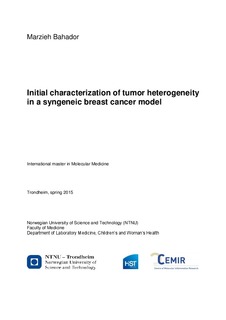| dc.description.abstract | Breast cancer is the most common cancer in women and the main reason of cancer death in the less developed countries. Metastasis is the leading cause of death in breast cancer patients. Due to the complexity of this cascade, many aspects of metastasis are still unknown and we still lack therapy to cure or prevent metastatic breath cancer. Differences in tumor microenvironment influence tumor characteristics. Infiltrated immune cells play an important role in cancer related inflammation and may promote metastasis. Macrophages are member of innate immunity and represent a major component of infiltrated cells within solid tumors. They can be classified to classically activated macrophages (M1) and alternatively activated macrophages (M2). Tumor associated macrophages (TAMs) contribute in initiation and progression of tumors and are predominantly M2 macrophages.
Animal models have been developed for studying function of macrophages in the tumor microenvironment. However, designing in vitro models that may mimic interaction between cancer cells and macrophages could simplify the studies of the multiple interactions in the tumor environment and may lead to better understanding of metastatic cascade. This study was focused on a syngeneic mouse model with a functioning immune system. A model of two BALB/cfC3H mouse cell lines, 66cl4 and 67NR isolated from the same primary tumor but with a different metastatic potential was chosen. Analyzes of transcriptome sequencing data obtained from the cell lines grown in culture and as tumors in mice demonstrated numerous transcripts present in the tumor but lacking in the cell lines. These differences in the transcriptome indicated several types of stroma cells recruited into the tumors. Comparing two mouse mammary primary tumors, 66cl4 (metastatic) and 67NR (non-metastatic), suggested that almost 40% of 66cl4 and 30% of 67NR primary tumors are consist of non-tumor cells. M2 macrophages are known for their contribution in breast tumor metastasis and progression. Presence of M2 macrophages in 66cl4 primary tumor, may correlates with metastatic potential of this primary tumor. In an attempt to mimic the interaction between the two cancer cell lines and immune cells, the macrophage cell lines RAW264.7 and IC-21 cell line was tested. The obtained results suggest that these two transformed macrophage cell lines are not responsive to signal emerging from the cancer cells. This study suggests that RAW264.7 and IC-21 cell lines cannot be ideal models for studying this interaction but that primary macrophages represents a better option for studies of how cancer cells may regulate normal macrophage function. | nb_NO |
